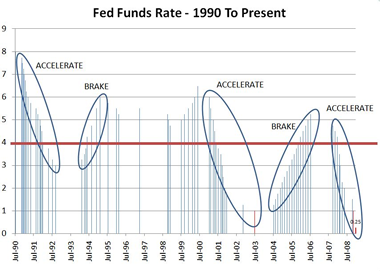Global Warming - It's What You Show
SEARCH BLOG: GLOBAL WARMING
In the last two days, I have shown the impact of how data is shown by displaying identical data in different ways that tell dramatically different stories. I will now return to the original temperature graph in its original form (expanded vertical axis) and a similar graph from another source with a similar display of the data. While the two charts below are from different sources, they show the same thing: temperatures have trended up over the past century.
The first chart, which was presented in 3 additional ways, is from Dr. Richard A. Muller, University of California, Berkeley. If you remember from posts the previous two days, the vertical scale is greatly exaggerated in order to show changes that, in clearer perspective, are quite small.
 Click for enlarged view
Click for enlarged viewWhat's the difference? The first chart is similar to many used to show that our climate is warming and make a connection to the fact that CO2 concentrations in the atmosphere are higher now than in recent history (but much lower than ice core data).
The second chart agrees and uses roughly the same scaling. Temperatures are higher now than a century ago. And it also shows CO2 levels at the highest level (at least in the last century).
So do the two professors agree? Well, at least partially. They both agree that temperatures have trended up slightly over the past century. But Dr. Patterson has raised a question that many others have, but is ignored by those adhering to the anthropogenic CO2 concept of global warming.
"If CO2 is of such critical importance to climate change why was there a large temperature rise prior to the early 1940s when 80 percent of the human produced carbon dioxide was produced after World War II? When CO2 levels finally began to increase dramatically in the postwar years why was there a concomitant interval of about 30 years of cooling? One would think that if CO2 had such critical control over climate that the relative abundance of CO2 in the atmosphere would be in lock step with global temperature. Many researchers realize the difficulties that are presented by trying to make CO2 the key factor in climate change."Climate modelers, such as those who write at RealClimate.org often simply ignore this as "old news" or some such and say that their models demonstrate that CO2, specifically anthropogenic CO2, is the driver of climate change... global warming, if you will. That's the point, they don't really address the anomaly, they dismiss it... based on a correlation at the tail end of the data.
Now, I can't tell you whether relative sunspot activity (as shown in Dr. Patterson's chart) or other factors that other scientists have identified, such as cosmic rays or phytoplankton, affected the relationship between temperature change and CO2. The point is, the relationship did change. CO2 increased for 30 years and temperatures trended downward for 30 years. Now temperatures have trended upward for 20 years while CO2 increased for 20 years.
What does dismissal of other factors explain? And why, or is, the inconsistency being ignored? And how do the models handle it? As an anomaly that is smoothed out?
In conclusion, there is a great deal of confusion among non-scientists and politicians regarding the nature of climate change and possible global warming. Much data has been presented in ways that, while not intentionally misleading, does mislead and possibly misinform as a result.As Dr. Michael Hulme, Director, Tyndall Centre for Climate Change Research said in an article published by the BBC, November 2006:
For example, in yesterday's chart, I compared a global average temperature to regional average temperatures and asked if the reader thought that a 1 degree C change looked all that significant. The answer is that there is probably no good way to predict, with certainty, if that amount of global temperature change will result in a similar change for all of the regional climates, or if some regions will be devastated while others are significantly improved... or if like the 20th century there are fluctuating changes in weather patterns over decades, but little long term relationship apparent.
In addition to the confusion regarding the significance of changes that have occurred and may occur, there are questions that seem to be ignored or brushed off as "unimportant" in an effort to provide a simple answer to a complex issue.
My hope is that this series of three posts have provided a beginning point for better understanding and discussion stripped of hyperbole and emotion, not only among scientists, but especially among non-scientists and politicians.
Consequently, I have separately emailed Senator Carl Levin from my state, Michigan, who is becoming more involved in the policy and legislation efforts about CO2 and global warming... and have asked him to consider the issues raised here during the last three days. With billions of dollars in the balance, including subsidies and penalties, our lawmakers should be certain of what we will be paying for before sending us the bill.
In order for politicians reasonably to make... or refrain from making... new policies or legislation related to controlling global warming or climate change, scientists need to:
- resolve differences in the factors that are relevant in assessing global temperature changes
- significantly improve the ability to project climate change by region to determine if changes are detrimental or beneficial to different regions
- provide realistic time scales for changes to occur
- assess if the focus on CO2 alone is appropriate, needed, and achievable
It seems that mere "climate change" was not going to be bad enough, and so now it must be "catastrophic" to be worthy of attention.It's how you say it; it's how you show it; it's what you show... and who you talk to about it.
The increasing use of this pejorative term - and its bedfellow qualifiers "chaotic", "irreversible", "rapid" - has altered the public discourse around climate change.
This discourse is now characterised by phrases such as "climate change is worse than we thought", that we are approaching "irreversible tipping in the Earth's climate", and that we are "at the point of no return".
I have found myself increasingly chastised by climate change campaigners when my public statements and lectures on climate change have not satisfied their thirst for environmental drama and exaggerated rhetoric.
It seems that it is we, the professional climate scientists, who are now the (catastrophe) sceptics. How the wheel turns.









